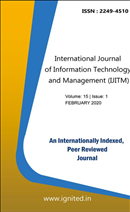A Review of Consumer Perceptions of the Implications of E-Commerce
Main Article Content
Authors
Abstract
A developing idea that symbolizes the practice of acquiring, selling, or exchanging services andinformation across computer networks, “is referred to as E-commerce. E-readiness refers to a company'scapability of successfully adopting, utilizing, and benefiting from information technology (IT) as in ecommerce.E-commerce is said to offer various advantages to SMEs, motivating them to embrace it.Customers give each other advice on everything from their favourite restaurant to their most dependabledoctor. WOM marketing is an informal method of transferring information from one customer to anotherthat does not require the participation of a marketer. Although additional forms of WOM merit investigation,the current study focuses on one type of WOM online user-generated assessments.
Downloads
Download data is not yet available.
Article Details
Section
Articles
References
- Zwass, V, (1996), 'Electronic Commerce: Structures and Issues', IJEQ Volume 1, no. 1, pp. 3-23.
- Zimmerer, T.W. and N.M. Scarborough (1998), Essentials of entrepreneurship and small business management, Upper Saddle River, NJ: Prentice Hall.
- Wong, Y., Hsu, C., & Steele, R. (2005). Technology acceptance model (TAMCom) for business to customer (B2C). Department of Management, Griffith University, Australia.
- Turban, E., King, D., Lee, J., & Viehland, D. (2004). Overview of electronic commerce. In R. Horan Editor. Electronic Commerce: A managerial perspective 2004 (pp.1-34). Upper Saddle River, New Jersey: Prentice Hall.
- Schulze, C. and Baumgartner, J. (2001), Don’t Panic, Do E-Commerce, A Beginner’s Guide to European Law Affecting E-Commerce, European Commission’s Electronic Commerce Team.
- Sarkar A, "E-Commerce Adoption and Implementation in SMEs: An Analysis of Factors", 21st Annual Conference of the National Advisory Committee on Computing Qualifications (NACCQ), Auckland, New Zealand, 2008: 309-319.
- Rose, G., & Straub, D. (1998). Predicting General IT use: Applying TAM to Arabic world. Journal of Global Information Management, 6(3), 39-46.
- Ratnasingam, P. (2005). Trust in inter-organizational exchanges: A case study in business to business electronic commerce. Decision Support System, 39, 525-544.
- Poon, S. (2000), “Business environment and Internet commerce benefit – a small business perspective”, European Journal of Information Systems, Vol. 9, pp. 72-81.
- Palvia, P., & D'Aubeterre, F. (2007). Examination of infomediary roles in B2C e-commerce. Journal of Electronic Commerce Research, 8,207-220. doi: 1388674851 992.
- Mandal, P. (2004). Inter-country analysis of e-business. Journal of Global Information Technology Management, 7(2), 1-5.
- Korper, S. and Ellis, J. (2001), The E-Commerce Book, Academic Press, San Diego, CA.
- Kharbanda, V.P. (2001), “Facilitating innovation in Indian small and medium enterprises – the role of clusters”, Current Science, Vol. 80 No. 3, pp. 343-8.
- Kalakota, R., & Robinson, M. (2001). e-Business 2.0 roadmap for success (2.0 ed.). New Jersey: AddisonWesley.
- Haynes, P., Becherer, R. and Helms, M. (1998), "Small and mid-sized businesses and Internet use: unrealized potential?", Internet Research: Electronics Networking Applications and Policy, Vol. 8 No. 3, pp. 229-35.
- Harrington, L. and Reed, G. (1996). Electronic Commerce Finally Comes of Age. The Mckinsey Quarterly, 2, 68-77.
- Hamill, J., & Stevenson, A. (2002). International marketing and the Internet. International Marketing Review, 19 (2/3), 323.
- Drew, S.A.W. (2003). E-Business research practice: Towards an Agenda. Electronic Journal on Business Research Methods 1(1).
- Dembla, P. Palvia, P., & Krishnan, B. (2007). Understanding the adoption of web-enabled transaction processing by small businesses. Journal of Electronic Commerce Research, 8(1), 1-17. doi: 1230897421
- Choi, J., & Geistfeld, L. (2004). A cross-cultural investigation of consumer e-shopping adoption. Journal of Economic Psychology, 25(6), 821-838.
- Choi, D. H., Kim, C. M., Kim, S., & Kim, S. H. (2006). Customer loyalty and disloyalty in internet retail stores: Its antecedents and its effect on customer price sensitivity. International Journal of Management, 23, 925- 941,944. doi: 1197221341

